Xi Liu
Bézier Splatting for Fast and Differentiable Vector Graphics
Mar 20, 2025Abstract:Differentiable vector graphics (VGs) are widely used in image vectorization and vector synthesis, while existing representations are costly to optimize and struggle to achieve high-quality rendering results for high-resolution images. This work introduces a new differentiable VG representation, dubbed B\'ezier splatting, that enables fast yet high-fidelity VG rasterization. B\'ezier splatting samples 2D Gaussians along B\'ezier curves, which naturally provide positional gradients at object boundaries. Thanks to the efficient splatting-based differentiable rasterizer, B\'ezier splatting achieves over 20x and 150x faster per forward and backward rasterization step for open curves compared to DiffVG. Additionally, we introduce an adaptive pruning and densification strategy that dynamically adjusts the spatial distribution of curves to escape local minima, further improving VG quality. Experimental results show that B\'ezier splatting significantly outperforms existing methods with better visual fidelity and 10x faster optimization speed.
External Large Foundation Model: How to Efficiently Serve Trillions of Parameters for Online Ads Recommendation
Feb 26, 2025



Abstract:Ads recommendation is a prominent service of online advertising systems and has been actively studied. Recent studies indicate that scaling-up and advanced design of the recommendation model can bring significant performance improvement. However, with a larger model scale, such prior studies have a significantly increasing gap from industry as they often neglect two fundamental challenges in industrial-scale applications. First, training and inference budgets are restricted for the model to be served, exceeding which may incur latency and impair user experience. Second, large-volume data arrive in a streaming mode with data distributions dynamically shifting, as new users/ads join and existing users/ads leave the system. We propose the External Large Foundation Model (ExFM) framework to address the overlooked challenges. Specifically, we develop external distillation and a data augmentation system (DAS) to control the computational cost of training/inference while maintaining high performance. We design the teacher in a way like a foundation model (FM) that can serve multiple students as vertical models (VMs) to amortize its building cost. We propose Auxiliary Head and Student Adapter to mitigate the data distribution gap between FM and VMs caused by the streaming data issue. Comprehensive experiments on internal industrial-scale applications and public datasets demonstrate significant performance gain by ExFM.
Effective Field Neural Network
Feb 24, 2025Abstract:In recent years, with the rapid development of machine learning, physicists have been exploring its new applications in solving or alleviating the curse of dimensionality in many-body problems. In order to accurately reflect the underlying physics of the problem, domain knowledge must be encoded into the machine learning algorithms. In this work, inspired by field theory, we propose a new set of machine learning models called effective field neural networks (EFNNs) that can automatically and efficiently capture important many-body interactions through multiple self-refining processes. Taking the classical $3$-spin infinite-range model and the quantum double exchange model as case studies, we explicitly demonstrate that EFNNs significantly outperform fully-connected deep neural networks (DNNs) and the effective model. Furthermore, with the help of convolution operations, the EFNNs learned in a small system can be seamlessly used in a larger system without additional training and the relative errors even decrease, which further demonstrates the efficacy of EFNNs in representing core physical behaviors.
Enhancing Offline Model-Based RL via Active Model Selection: A Bayesian Optimization Perspective
Feb 17, 2025Abstract:Offline model-based reinforcement learning (MBRL) serves as a competitive framework that can learn well-performing policies solely from pre-collected data with the help of learned dynamics models. To fully unleash the power of offline MBRL, model selection plays a pivotal role in determining the dynamics model utilized for downstream policy learning. However, offline MBRL conventionally relies on validation or off-policy evaluation, which are rather inaccurate due to the inherent distribution shift in offline RL. To tackle this, we propose BOMS, an active model selection framework that enhances model selection in offline MBRL with only a small online interaction budget, through the lens of Bayesian optimization (BO). Specifically, we recast model selection as BO and enable probabilistic inference in BOMS by proposing a novel model-induced kernel, which is theoretically grounded and computationally efficient. Through extensive experiments, we show that BOMS improves over the baseline methods with a small amount of online interaction comparable to only $1\%$-$2.5\%$ of offline training data on various RL tasks.
Latent Radiance Fields with 3D-aware 2D Representations
Feb 13, 2025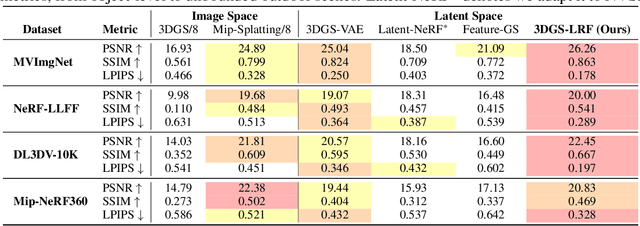



Abstract:Latent 3D reconstruction has shown great promise in empowering 3D semantic understanding and 3D generation by distilling 2D features into the 3D space. However, existing approaches struggle with the domain gap between 2D feature space and 3D representations, resulting in degraded rendering performance. To address this challenge, we propose a novel framework that integrates 3D awareness into the 2D latent space. The framework consists of three stages: (1) a correspondence-aware autoencoding method that enhances the 3D consistency of 2D latent representations, (2) a latent radiance field (LRF) that lifts these 3D-aware 2D representations into 3D space, and (3) a VAE-Radiance Field (VAE-RF) alignment strategy that improves image decoding from the rendered 2D representations. Extensive experiments demonstrate that our method outperforms the state-of-the-art latent 3D reconstruction approaches in terms of synthesis performance and cross-dataset generalizability across diverse indoor and outdoor scenes. To our knowledge, this is the first work showing the radiance field representations constructed from 2D latent representations can yield photorealistic 3D reconstruction performance.
Surgical Visual Understanding (SurgVU) Dataset
Jan 16, 2025



Abstract:Owing to recent advances in machine learning and the ability to harvest large amounts of data during robotic-assisted surgeries, surgical data science is ripe for foundational work. We present a large dataset of surgical videos and their accompanying labels for this purpose. We describe how the data was collected and some of its unique attributes. Multiple example problems are outlined. Although the dataset was curated for a particular set of scientific challenges (in an accompanying paper), it is general enough to be used for a broad range machine learning questions. Our hope is that this dataset exposes the larger machine learning community to the challenging problems within surgical data science, and becomes a touchstone for future research. The videos are available at https://storage.googleapis.com/isi-surgvu/surgvu24_videos_only.zip, the labels at https://storage.googleapis.com/isi-surgvu/surgvu24_labels_updated_v2.zip, and a validation set for tool detection problem at https://storage.googleapis.com/isi-surgvu/cat1_test_set_public.zip.
The Efficiency vs. Accuracy Trade-off: Optimizing RAG-Enhanced LLM Recommender Systems Using Multi-Head Early Exit
Jan 04, 2025



Abstract:The deployment of Large Language Models (LLMs) in recommender systems for predicting Click-Through Rates (CTR) necessitates a delicate balance between computational efficiency and predictive accuracy. This paper presents an optimization framework that combines Retrieval-Augmented Generation (RAG) with an innovative multi-head early exit architecture to concurrently enhance both aspects. By integrating Graph Convolutional Networks (GCNs) as efficient retrieval mechanisms, we are able to significantly reduce data retrieval times while maintaining high model performance. The early exit strategy employed allows for dynamic termination of model inference, utilizing real-time predictive confidence assessments across multiple heads. This not only quickens the responsiveness of LLMs but also upholds or improves their accuracy, making it ideal for real-time application scenarios. Our experiments demonstrate how this architecture effectively decreases computation time without sacrificing the accuracy needed for reliable recommendation delivery, establishing a new standard for efficient, real-time LLM deployment in commercial systems.
APOLLO: SGD-like Memory, AdamW-level Performance
Dec 09, 2024



Abstract:Large language models (LLMs) are notoriously memory-intensive during training, particularly with the popular AdamW optimizer. This memory burden necessitates using more or higher-end GPUs or reducing batch sizes, limiting training scalability and throughput. To address this, various memory-efficient optimizers have been proposed to reduce optimizer memory usage. However, they face critical challenges: (i) reliance on costly SVD operations; (ii) significant performance trade-offs compared to AdamW; and (iii) still substantial optimizer memory overhead to maintain competitive performance. In this work, we identify that AdamW's learning rate adaptation rule can be effectively coarsened as a structured learning rate update. Based on this insight, we propose Approximated Gradient Scaling for Memory-Efficient LLM Optimization (APOLLO), which approximates learning rate scaling using an auxiliary low-rank optimizer state based on pure random projection. This structured learning rate update rule makes APOLLO highly tolerant to further memory reductions while delivering comparable pre-training performance. Even its rank-1 variant, APOLLO-Mini, achieves superior pre-training performance compared to AdamW with SGD-level memory costs. Extensive experiments demonstrate that the APOLLO series performs on-par with or better than AdamW, while achieving greater memory savings by nearly eliminating the optimization states of AdamW. These savings provide significant system-level benefits: (1) Enhanced Throughput: 3x throughput on an 8xA100-80GB setup compared to AdamW by supporting 4x larger batch sizes. (2) Improved Model Scalability: Pre-training LLaMA-13B with naive DDP on A100-80GB GPUs without system-level optimizations. (3) Low-End GPU Friendly Pre-training: Pre-training LLaMA-7B on a single GPU using less than 12 GB of memory with weight quantization.
InterFormer: Towards Effective Heterogeneous Interaction Learning for Click-Through Rate Prediction
Nov 15, 2024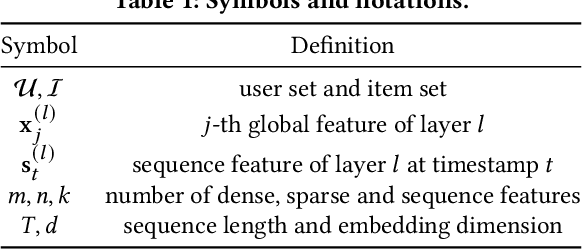
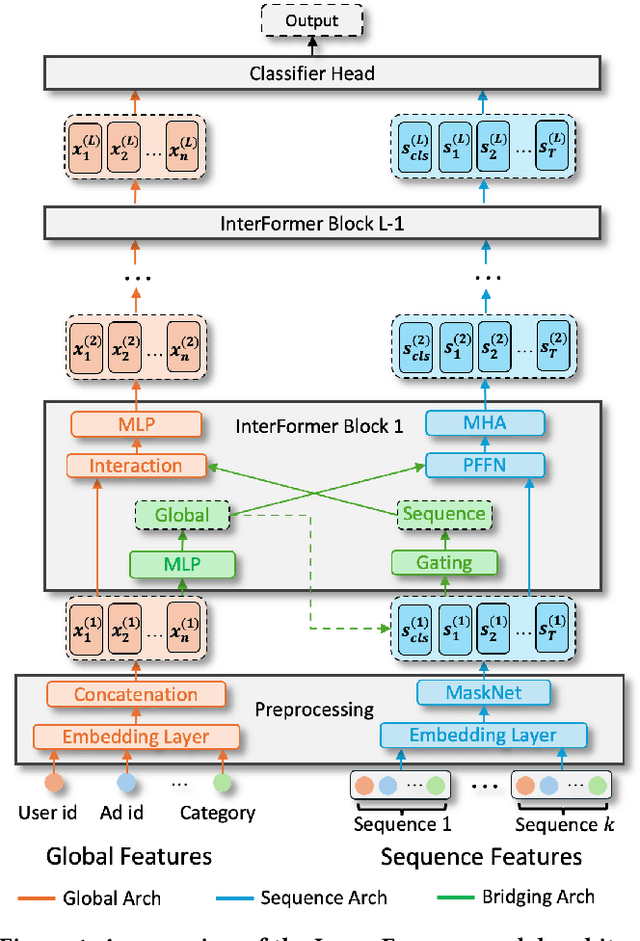

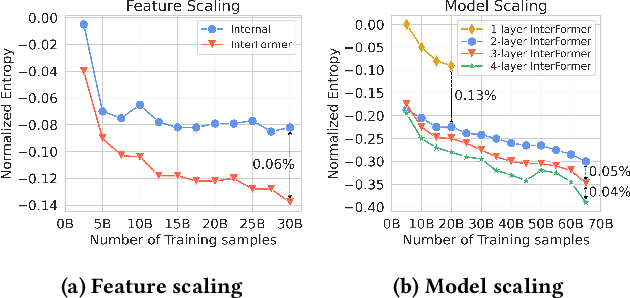
Abstract:Click-through rate (CTR) prediction, which predicts the probability of a user clicking an ad, is a fundamental task in recommender systems. The emergence of heterogeneous information, such as user profile and behavior sequences, depicts user interests from different aspects. A mutually beneficial integration of heterogeneous information is the cornerstone towards the success of CTR prediction. However, most of the existing methods suffer from two fundamental limitations, including (1) insufficient inter-mode interaction due to the unidirectional information flow between modes, and (2) aggressive information aggregation caused by early summarization, resulting in excessive information loss. To address the above limitations, we propose a novel module named InterFormer to learn heterogeneous information interaction in an interleaving style. To achieve better interaction learning, InterFormer enables bidirectional information flow for mutually beneficial learning across different modes. To avoid aggressive information aggregation, we retain complete information in each data mode and use a separate bridging arch for effective information selection and summarization. Our proposed InterFormer achieves state-of-the-art performance on three public datasets and a large-scale industrial dataset.
3DGS-Enhancer: Enhancing Unbounded 3D Gaussian Splatting with View-consistent 2D Diffusion Priors
Oct 21, 2024
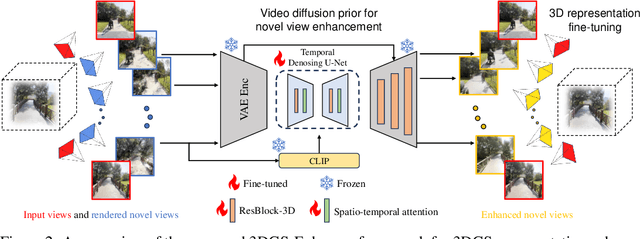

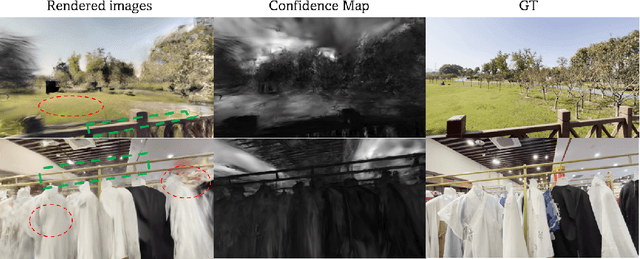
Abstract:Novel-view synthesis aims to generate novel views of a scene from multiple input images or videos, and recent advancements like 3D Gaussian splatting (3DGS) have achieved notable success in producing photorealistic renderings with efficient pipelines. However, generating high-quality novel views under challenging settings, such as sparse input views, remains difficult due to insufficient information in under-sampled areas, often resulting in noticeable artifacts. This paper presents 3DGS-Enhancer, a novel pipeline for enhancing the representation quality of 3DGS representations. We leverage 2D video diffusion priors to address the challenging 3D view consistency problem, reformulating it as achieving temporal consistency within a video generation process. 3DGS-Enhancer restores view-consistent latent features of rendered novel views and integrates them with the input views through a spatial-temporal decoder. The enhanced views are then used to fine-tune the initial 3DGS model, significantly improving its rendering performance. Extensive experiments on large-scale datasets of unbounded scenes demonstrate that 3DGS-Enhancer yields superior reconstruction performance and high-fidelity rendering results compared to state-of-the-art methods. The project webpage is https://xiliu8006.github.io/3DGS-Enhancer-project .
 Add to Chrome
Add to Chrome Add to Firefox
Add to Firefox Add to Edge
Add to Edge